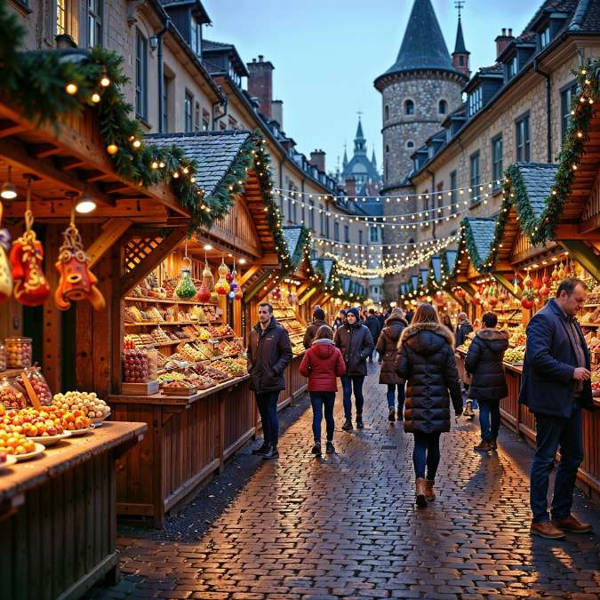
(War truces, weird customs & holiday oddities you won’t believe)
Christmas is often cast as a season of warmth, family, and tradition — but throughout history it has also played host to surprises. From ceasefires in the midst of war to bizarre local rituals that mix haunting and humor, some Christmases have been downright strange. In this article, we explore a selection of the oddest, most extraordinary Christmases ever recorded — and what they tell us about human culture and hope.
The Legendary Christmas Truce of 1914
One of the best-known “strange” Christmases is the spontaneous Christmas Truce during World War I. Late on Christmas Eve, British, German, and (in some sectors) French troops along parts of the Western Front ceased hostilities, met in no-man’s land, exchanged gifts, sang carols, and in a few stories, played football.
What exactly happened
- After months of grueling trench warfare, Christmas Eve 1914 brought an informal ceasefire in many sectors. Some German troops decorated parts of their trenches with small trees or lanterns, and sang carols. Opposing troops responded in kind.
- Soldiers emerged into no man’s land to shake hands, exchange souvenirs, bury the dead left between trenches, and in anecdotal accounts, arrange impromptu football matches.
- The truce was not uniform. In many sectors, fighting continued, some officers disapproved and fired on soldiers entering no man’s land, and after Christmas Day, hostilities resumed.
The football myth
Stories of formal soccer matches between opposing troops are vivid — but historians debate how real they were. Some suggest that the “football match” tales are embellishment or retrospective romanticizing. In some cases, troops may have kicked around a tin or improvised ball, but large, organized matches may be exaggerated.
Legacy & meaning
The Christmas Truce stands as a symbolic moment — a glimpse of shared humanity amid brutal conflict. Military command on both sides later discouraged such fraternization, and repeat truces on this scale never occurred.
Other Wartime & Ceasefire Christmases
While 1914’s truce is most famous, Christmases during war have often borne odd or poignant notes:
- Later WWI small fraternizations: Although large-scale truces didn’t again take hold, historians have documented smaller local pauses or “live-and-let-live” practices where opposing soldiers tacitly avoided fire in low-activity sectors.
- Second World War Christmases: In occupied zones and battle regions, Christmas observances were often makeshift, clandestine, or suppressed. In some prisoner-of-war camps, captives attempted modest celebrations — sharing small food, secret carols, or religious services under pain of punishment. (I did not find a single unified “Christmas truce” in WWII comparable to 1914 in trusted sources.)
- Modern conflict anomalies: There are occasional reports (less documented) of troops in modern conflicts pausing fire around religious holidays, but none on the scale or symbolism of 1914 have been confirmed in open historical records.
Because records are patchy and wartime censorship is strong, many smaller instances may lie buried in letters or archives.
Dark, Ghostly & Supernatural Christmas Traditions
Christmas has also long carried shadows — ghost stories, demonic folklore, and uncanny practices.
- Victorian ghost tales: In the 19th century, reading ghost stories at Christmas became somewhat of a tradition in Britain. The holiday merged with spiritualist and gothic moodiness. (Think: Dickens’s A Christmas Carol with its ghost visitations.)
- Lord of Misrule / Christmas Misrule: Echoing Saturnalia, in medieval and early modern Europe, a “Lord of Misrule” might be appointed to lead wild revels, chaos, mockery, and inversion of social order during the Twelve Days of Christmas (Dec 25 – Jan 5). Some see this as a reversal ritual allowing safe carnival energy.
- Kallikantzaroi / goblins in Greek tradition: In Greek folklore, during the 12 days of Christmas, malevolent goblins (Kallikantzaroi) roam the world, causing mischief until banished on Epiphany.
- Dark folklore in Alpine/central Europe: Figures like Krampus (half-goat demon punisher of misbehaving children), Perchten and the Perchtenlauf (mask-wearing winter spirits) roam in December in Austrian, Tyrolean, Bavarian folklore.
- The Mari Lwyd: In Wales, a folk custom (first recorded ca. 1800) involves carrying a horse skull (“Mari Lwyd”) mounted on a pole, hidden under cloth. Groups visit houses, performing rhymed verses and challenging entry; the household must reply in kind. It evokes older “wassailing” or mumming customs with eerie flair.
These customs show Christmas isn't always sweet or serene — it’s interwoven with deeper, sometimes darker strands of folk belief.
Bizarre Customs Around the World
Beyond wartime pauses and folklore, many Christmas traditions around the world are delightfully odd. Here are several remarkable ones still practiced or historically recorded:
Catalonia’s Caganer & Caga Tió (Spain / Catalonia)
- Caganer: In Catalan nativity scenes, you often find a small figurine of a person defecating (pants lowered) hidden among the stable and shepherds. It’s known as caganer (“the pooper”). This irreverent figure has long been part of Catalan tradition, possibly symbolizing fertility, earthiness, or leveling of sanctity.
- Caga Tió / Tió de Nadal: A wooden log with a painted smiling face and blanket is “fed” treats in the days before Christmas. On Christmas Eve or Day, children beat the log with sticks while singing, commanding it to defecate — i.e. “poop” presents: candy, small gifts, etc. It’s a humorous, ritualistic inversion celebrated in many Catalan households.
These vivid customs combine humor, earthiness, tradition, and festive irreverence.
Mari Lwyd in Wales
As mentioned, the Mari Lwyd tradition—horse skull on a pole, rhyme battles at doors—evokes medieval mumming and revelers, with a ghostly, liminal edge. It is a reminder that some Christmas customs retain their older folk and ritual roots. Wikipedia
Krampus, Perchten & Shadow Figures
- Krampus: In Alpine folklore, Krampus is the dark counterpart to St. Nicholas. He punishes naughty children, sometimes appearing in Krampus runs (parades where masked figures roam). Many towns still hold Krampusnacht events.
- Perchten / Perchtenlauf: In Austrian and southern German folklore, Perchten are mask-wearing spirits or beasts who parade through towns in December, often as part of rituals to drive out evil or winter darkness.
- Frau Perchta: A mythical figure who wanders during the 12 days of Christmas, sometimes punishing laziness or rewarding industriousness.
These shadowy figures add an element of fear, moral warning, or festival inversion into the Christmas season.
Klausjagen in Switzerland
In the Swiss town of Küssnacht, Klausjagen (the “Nicholas chase”) is a noisy, candlelit procession on the eve of St. Nicholas Day (Dec 5). Men crack long sheep whips, carry giant illuminated paper hats (often 7 feet tall), blow cow horns, and ring bells. The custom has pagan roots (chasing wild spirits), later “Christianized.”
This custom shows how Christmas time (or adjacent saint days) can host exuberant, riotous parades very different from gentle carols and nativity scenes.
KFC Christmas in Japan
One of the modern oddities: in Japan, eating KFC (Kentucky Fried Chicken) at Christmas is a popular tradition. A 1970s advertising campaign (“Kurisumasu ni wa kentakkii!”) helped popularize this. Many Japanese families preorder KFC buckets for Christmas dinner.
A fast-food meal as a Christmas tradition — perhaps unexpected, bizarre to outsiders, but real and widely practiced.
Hiding Brooms, Throwing Shoes & More
- Hiding brooms in Norway: On Christmas Eve, Norwegian tradition includes hiding all brooms (and mops) in the house to prevent witches, evil spirits, or mischievous beings from stealing them.
- Shoe-throwing in Czech Republic: Single women toss a shoe over their shoulder toward the door on Christmas Eve; if it lands pointing toward the door, it’s said they will marry the next year.
- Eating raw whale or decomposed seabirds in Greenland: In Greenland, traditional Christmas foods include mattak (whale skin and blubber) and kiviak (auks fermented in seal skin) — delicacies reserved for special occasions.
These practices show how deeply local culture, environment, and folklore shape how people mark Christmas.
Unusual Public Events & Record-Breaking Santas
Beyond local weirdness, there are large-scale events and records that push Christmas into outlandish territory:
- Buon Natale, Thrissur (India): Since 2013, the city of Thrissur in Kerala holds a giant Santa Claus procession. In 2014, 18,112 Santas and angels participated, setting a Guinness World Record.
- Mass Santa gatherings in other cities: Some cities organize Santa parades or gatherings where thousands dress as Santa. These become festive spectacles, social events, fundraisers.
- Christmas parades & spectacle displays: Some cities create extravagant light shows, giant inflatables, synchronized spectacles, “light tunnels,” or laser shows — pushing the boundary of holiday decor into immersive sensory experiences.
These events show how Christmas ritual scales from the personal to the performative and even record-breaking.
What Fuels These Strange Christmases? Themes & Interpretations
Why do such odd Christmases emerge? A few interpretive lenses help us see what’s going on:
Ritual adaptation & syncretism
Many “strange” customs are older rituals adapted or survived by syncretism. Pagan midwinter celebrations, local folk practices, community rituals — all get folded into Christmas, often retaining odd elements that are no longer fully explained.
Inversion, carnival & festivity
Some customs (Lord of Misrule, Pooping Log, Krampus, Mari Lwyd) invoke inversion — turning norms upside-down, mockery, frightening or comic elements in a safe ritual frame. Festivity often thrives on boundary-pushing.
Cultural identity & local flavor
Every community remixes Christmas via its local language, climate, resources, and history. Customs reflect environment (whale in Greenland), humor styles (Catalonia), folk heritage (Mari Lwyd), or colonial influences (KFC in Japan).
Resistance & heterodoxy
In contexts of occupation or war, Christmas celebrations may take on covert meanings or even temporary peace gestures (e.g. the 1914 Truce). Symbolic acts can carry political or moral resonance.
Spectacle, commercialization & social media potential
Modern odd events (mass Santas, light shows) play into spectacle, tourism, fundraising, media coverage, and social media shareability. The stranger or larger it is, the more attention.
Tips for Curious Christmas Travelers & Enthusiasts
If you love holiday oddities, here are some tips to see the strangest Christmases in person or virtually:
- Research local traditions ahead — look up region-specific customs, folk legends, seasonal pages.
- Visit in December / January — many of these customs happen especially in the Twelve Days (Dec 25 to Jan 6) or on saint days.
- Respect local meaning — what seems odd from outside often has deep meaning for locals.
- Take photos and ask stories — folk customs are rich in narrative; asking participants to tell you why can yield insights.
- Blend with regular tourism — pair classic Christmas markets, museums, or heritage sites with curious side rituals.
- Learn old languages / folklore terms — knowing what caganer, Mari Lwyd, Klausjagen mean helps you spot them.
- Check local event calendars — parades, masquerades, Santa gatherings often advertised locally.
Conclusion
From ceasefires in the trenches to defecating logs, skull horses, masked beasts, and fast-food Christmas dinners — the tapestry of “strange Christmases” is wide and fascinating. These anomalies remind us that Christmas isn’t a monolith: it is a canvas reinterpreted by war, wariness, humor, folklore, spectacle, and human creativity.
When you hear of a KFC queue in Tokyo or a giant Santa parade in India—or dig into the legend of the 1914 Truce—remember: each oddity is a thread in a larger story of how humanity tries to bring light, meaning, and ritual to the darkest season.
Sources
- “The Real Story of the Christmas Truce of 1914,” Imperial War Museums
- History.com — WWI’s Christmas Truce
- Britannica — Christmas Truce
- National WWI Museum & Memorial — Christmas During World War I
- Wikipedia — Christmas Truce, Guise dancing, Klausjagen, Mari Lwyd
- Wanderlust Magazine — 12 Weirdest Christmas Traditions
- Mental Floss — 8 Truly Strange Christmas Customs
- Holiday Extras / Regent Holidays — Unusual Christmas traditions roundups
- Travel + Leisure — Unique Christmas Traditions
- The Sun / media sources — European unusual Christmas accounts

